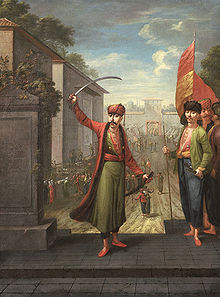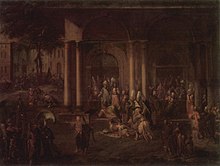Patrona Halil uprising
The Patrona Halil Uprising took place in the Ottoman Empire in 1730 and led to the overthrow of Sultan Ahmed III.
Patrona Halil
The uprising was led by the Albanian Janissary Patrona Halil, who came from the then Macedonian Orestida (now Argos Orestiko Greece ). Patrona Halil first served as a seaman on the flagship of the Ottoman Navy. Patrona is the rank on an Ottoman ship. 1st rank is the Kapudane = ship's captain, 2nd piyale = captain's deputy, 3rd is the riyale, thus the 2nd deputy. As a janissary he was involved in the uprising in Niš and in 1720 led another uprising in Vidin . Patrona Halil fled to the capital Istanbul after the uprisings , where he earned his living as a hammam overseer, among other things . He often stayed in the inns in Galata . Halil was known as Horpeşteli Arnavut Halil, but his comrades called him Patrona (Vice Admiral).
The riot

The uprising was triggered by a war with Persia , which ended in catastrophe. The Janissaries took control of the Ottoman capital and demanded from the Sultan the extradition of the Grand Vizier Nevşehirli Damat İbrahim Pasha , whom they blamed for the defeat. Under Nevşehirli Damat İbrahim Pascha, the period of the tulip time , which increased the resentment of the rebels, began. The Sultan gave in, but was deposed himself in September. The Grand Vizier and some of his companions such as Nedîm were killed.
Many stately mansions in the Kağıthane district and other buildings, which in the eyes of the insurgents represented the decadence of the tulip era, were destroyed. Four weeks after the uprising, the empire was in the hands of the insurgents. Patrona Halil rode with the designated Sultan Mahmud I to the Eyup Sultan Mosque , where he was named Sultan in a ceremony with the sword of Osman. Many of the senior members of the government were removed and new ones installed by the rebels. Patrona Halil asked the Dīwān (German: Council of State), the Greek butcher Yanaki, who had supported Patrona Halil with money, to appoint the Gospodar of Moldova .
But over time, the rebels' arrogance became intolerable. So the Khan of Crimea , who was in Istanbul at the time, the Ottoman Grand Vizier, the Mufti and the Agha of the Janissaries managed to free the government from the rebels. Patrona Halil was tried and sentenced to death. 7,000 other insurgents, including his Greek friend Yanaki, were also executed. The uprising had lasted for almost two months and was quickly ended by the envy of the other Janissary officers for Patrona Halil and their willingness to get rid of him.
In the chronicle “ Tarih-i göynüklü ” by Göynüklü Ahmed Efendi these events are described in detail.
Effects
The uprising partially ended the tulip season, during which the empire opened up to Europe and, above all, had contacts with France. In Istanbul, for example, new gardens were laid out and palaces built based on the French palace gardens. A flow of ideas and literature emerged, so the printing of letters under Sultan Ahmed III. introduced. These reforms and innovations were felt by many to represent decadence and distance from religion.
literature
- Hans Georg Majer: Halil, Patrona , in: Biographical Lexicon for the History of Southeast Europe. Vol. 2. Munich 1976, p. 115 f.
